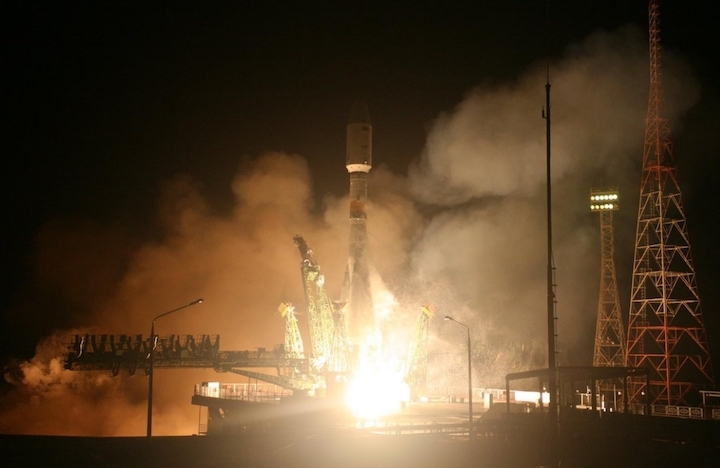21.02.2019

A Russian-built Earth observation satellite designed to provide reconnaissance imagery to Egyptian military officials is ready for launch Thursday from the Baikonur Cosmodrome in Kazakhstan on top of a Soyuz rocket.
The EgyptSat-A spacecraft and its Soyuz 2-1.b booster arrived at the Complex 31 launch pad Monday at Baikonur on the sprawling steppes of Kazakhstan. Hydraulic lifts hoisted the rocket vertical at the launch pad, and gantry arms rotated around the launcher for workers to complete final preflight preparations.
Thursday’s mission will mark Russia’s first space mission of the year, hauling a satellite to orbit for Egypt to replace the EgyptSat 2 Earth-imaging satellite, which failed in orbit in 2015, one year into a planned 11-year mission. Built by RSC Energia, a Moscow-based aerospace contractor, the EgyptSat-A satellite was manufactured with money from an insurance payout from the loss of EgyptSat 2, according to Russia’s Tass news agency.
Russian news reports said the development of EgyptSat-A cost approximately $100 million.
The satellite weighs more than a ton fully fueled, and Tass reported EgyptSat-A features several improvements over the EgyptSat 2 design, including improved solar batteries and a high-speed radio link with ground stations.
The spacecraft’s electro-optical imaging system includes an Earth-viewing telescope and camera that can spot surface features as small as 3.3 feet (1 meter), with similar capabilities as the failed EgyptSat 2 satellite. EgyptSat-A is the third Egyptian Earth observation satellite built in Russia, following the EgyptSat 1 spacecraft launched in 2007 and EgyptSat 2 launched in 2014.
Like its predecessor, EgyptSat-A is owned by Egypt’s National Authority for Remote Sensing and Space Sciences, a government agency tasked with gathering and studying satellite imagery of the Earth. Primary users of EgyptSat-A’s imagery are expected to include Egyptian military and security forces, intelligence analysts, emergency responders, environmental monitoring experts, and the agricultural sector.
EgyptSat-A is set for liftoff aboard a Soyuz-2.1b rocket at 1647 GMT (11:47 a.m. EST) Thursday. Russia’s space agency, Roscosmos, said it planned to provide a live webcast of the liftoff, but the live video feed never materialized before the launch.
The launch is timed for 9:47 p.m. local time at the Baikonur launch base, a facility leased from Kazakhstan by the Russian government. Local authorities in Kazakhstan adjusted the Baikonur time zone one hour earlier in December, making the local time now two hours ahead of Moscow.
The three-stage Soyuz booster will head north from Baikonur after liftoff, releasing its four first stage boosters to fall to Earth around two minutes into the flight. The core stage, also known as the second stage, will fire its engine for nearly five minutes, then separate as the third stage’s RD-0124 engine ignites to send the EgyptSat-A spacecraft and its Fregat upper stage toward orbit.
The Fregat upper stage will deploy from the Soyuz third stage around nine minutes into the mission, then begin maneuvers to place EgyptSat-A into its planned polar orbit.
Russian engineers will hand over control EgyptSat-A to Egyptian officials after the conclusion in in-orbit checkouts, according to Energia.
Quelle: SN
+++
Soyuz 2-1b launches EgyptSat-A – suffers apparent issues – but deemed successful

Russia’s first satellite launch of 2019 took place Thursday, with a Soyuz-2-1b/Fregat rocket lifting off from the Baikonur Cosmodrome at 23:47 local time (16:47 UTC) carrying the EgyptSat-A spacecraft. The spacecraft has separated, but it was initially unknown if the satellite was in the correct orbit after Russian media reported issues during either the third stage or Fregat period of flight. Roscosmos later claimed the launch was a success, potentially pointing to a heroric effort from the Fregat to save the mission.
EgyptSat-A is a high-resolution Earth observation satellite developed by Russian corporation RKK Energia on behalf of Egypt’s National Authority for Remote Sensing and Space Sciences (NARSS). The satellite carries a multispectral imaging payload based on that flown aboard a previous satellite, EgyptSat-2, which could take pictures of the surface at resolutions of up to 4 metres (13 feet), or 1 metre (3 feet) when operating in panchromatic mode – combining all wavelengths of light into a single monochrome image.
RKK Energia’s 559GK bus serves as the basis for the EgyptSat-A satellite, which has a hexagonal prism shape with three deployable solar panels and SPD-70 xenon-ion thrusters for on-orbit maneuvering. The satellite’s mass is likely around 1,000 kilograms (2,200 lb) – similar to its predecessor EgyptSat-2.
EgyptSat-A is an evolution of the EgyptSat-2 spacecraft which launched in April 2014. Also built around Energia’s 559GK platform, EgyptSat-2 was expected to operate for eleven years but was declared a total loss after the failure of both its primary and secondary onboard computers a few seconds apart on 12 April 2015 – four days before the first anniversary of its launch. The earlier EgyptSat-1 satellite also ceased operations short of its planned lifespan, suffering a communications malfunction three years and three months into its five-year mission.
Compared to EgyptSat-2, EgyptSat-A incorporates modernized electrical and flight control systems, an improved imaging payload, a higher-throughput communications system and more efficient solar arrays. EgyptSat-A will also benefit from a more powerful carrier rocket, allowing it to be placed into a sun-synchronous orbit more suited to Earth imaging than the lower-inclination orbit in which EgyptSat-2 operated. The sun-synchronous orbit is a type of near-polar low Earth orbit that allows a satellite to pass over each point on the Earth’s surface at the same mean solar time for consistent lighting conditions.
A Soyuz-2-1b rocket was used to launch EgyptSat-A, with a Fregat-M upper stage performing the satellite’s final insertion into sun-synchronous orbit, in contrast to the Soyuz-U rocket without an upper stage that was used to launch EgyptSat-2. Soyuz flew from Launcher 6 at Site 31 of the Baikonur Cosmodrome in Kazakhstan. Site 31/6 is one of two operational Soyuz pads at Baikonur – alongside the more well-known Site 1/5. Both pads were originally constructed for trials of Sergei Korolev’s R-7 missile in the 1950s, with Site 31 supporting its first launch in 1961.
